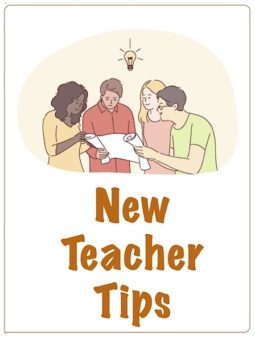The Bumps and Scrapes of First Year Teaching
A MiddleWeb Blog

I stopped driving to work about 4 months ago. The spike in fuel prices made traveling in a run-down, gas-guzzling truck cost prohibitive. Lucky for me, my house isn’t terribly far from where I teach. Once out of my neighborhood, it’s a straight shot down a 2-mile hill to campus.
Instead of walking, I decided to start riding my son’s longboard to work. Longboards, if you’re not familiar with them, are longer and wider than normal skateboards and used to cruise and carve, particularly when riding downhill at high speeds.

So far, there have been some scrapes, bruises, a couple of embarrassing falls, and a few close calls. But…I’ve survived and even grown to enjoy the challenging daily commute.
For new teachers, the first year in the profession can feel just as precarious. We find ourselves clinging to the edge of chaos and struggling to navigate various instructional, organizational, and personal challenges along the way. Thankfully, education research and the wisdom of veteran practitioners provide several helpful suggestions to help teachers survive – and even thrive – in their rookie year.
Seek out Supportive, Effective Mentors
Effective coaching and mentoring can make all the difference in your first year of teaching. Even when you’ve been assigned a mentor teacher, it’s imperative that new educators seek out a couple of expert practitioners to learn and grow with.
As educators, few things are more helpful than surrounding ourselves with individuals who are positive (not cynical) about the profession. Creating a small, trusted circle of energetic colleagues gives us an avenue to ask for constructive, timely, specific feedback about our instruction, classroom interactions, and performance.
Working with others to figure out the puzzles also helps ensure we develop key instructional practices and effective behavior management skills during our first crucial years in the classroom.
Ask to watch. Identify one or two specific teaching elements you’re struggling with, then carve out time to observe other teachers in action (particularly those who excel in the areas you wish to improve in). Despite the many demands on your time, be intentional about creating opportunities to “marinate” in the effective practices of others to ensure as much improvement as possible during your first year.
Create a Positive, Well-Managed Classroom Environment
Most teachers will agree that few aspects of teaching are more crucial to student (and teacher) success than effective classroom management. Creating a classroom culture that promotes social–emotional, academic, and behavioral learning needs to be a top priority.
It takes consistent, conscious effort, however, for beginning teachers to move beyond mere “crowd control” towards promoting positive self-discipline in our students. A well managed classroom environment is most likely to result when we make these things our goals:
- Activities designed to interest and challenge learners.
- A teacher’s sincere desire to help each student (even the most “prickly” and challenging ones) experience success.
- Clear and consistent behavioral expectations and classroom procedures.
- Constant monitoring of student performance and behavior.
- Behavioral and instructional strategies that increase on-task performance across the classroom and address student misbehavior with consistency and kindness.
Despite our best efforts, we will still encounter a significant amount of off-task and/or disruptive behavior. Keep in mind that a positive, well-managed classroom environment is NOT something we either achieve or fail to achieve. It’s a continual effort we make to propagate a culture of high expectations and support that enfolds every learner in our classroom.

Monitor and Manage Stress
It’s no secret that teaching has evolved into one of the most challenging, stressful professions in existence. While stress is an inevitable part of life in the classroom, it’s far too easy to let things get out of balance when we get too busy and overwhelmed.
To keep stress at a healthy level, here’s what I (and the experts) recommend:
- Establish and maintain healthy habits that include sufficient rest, a balanced diet, and consistent exercise. You’re going to need your strength to weather a world of new responsibilities (and exotic new germs!) amid the daily turmoil of first-year teaching.
- Avoid the temptation to spend all your time planning, teaching, grading, and fretting. Each of us needs to regularly carve out time to do other things that bring us joy and fulfillment. Learn something new, keep up with your hobby, find a binge-worthy show on TV. Get some perspective.
- Dedicate a small slice of time each day to recenter, breath, and improve you own emotional well-being. Mindfulness isn’t just for students. Seek out mindfulness strategies through articles, YouTube videos, and phone apps that work for you. Doing these things will make us more effective at managing and reducing conflict and experiencing greater satisfaction in the classroom.
For other helpful hints on stress management for teachers, see my earlier post here at MiddleWeb.
It’s a Rough (But Rewarding) Road
When I started longboarding earlier this year, I wasn’t fully prepared for the steep learning curve that it would pose. I thought…Why would longboarding be any more challenging than snowboarding, surfing or other board sports I’ve done in the past?
It didn’t take me long to realize that concrete and asphalt are far less forgiving than water or snow! During the first week, I took a nasty spill when my front wheels clipped a raised edge of pavement. The enthusiasm and confidence I had felt minutes before was reduced to rubble. In the days that followed, I spent most of my time cautiously and obsessively scanning the terrain ahead of me, then slowing down at the slightest hint of trouble. (I expect you can see the teaching analogy here.)
After a few miserable days, I spoke with a much more seasoned rider who chuckled and said… “Longboarding is tough. You’re gonna’ hit some bumps and get some scrapes. Just embrace it.”
He ended up being right on multiple counts. The less I worried about falling…the less I fell. When I did wobble, careen, and wipe out, I dusted myself off and jumped back on the board. I focused on making small adjustments, rather than nursing my battered flesh and wounded ego.
The same lessons apply to a teacher’s first trial-by-fire year in the profession. Despite our best efforts, each one of us will consistently experience trials, disappointments, and struggles in the classroom. These inevitable challenges will work either as stumbling blocks…or stepping stones to personal and professional growth and success.
As someone who’s been where you will be this year, I really urge you to embrace the challenging reality of our profession, work with trusted colleagues (who have been there too) and become a bit better each and every day.



































Great job Curtis Chandler.